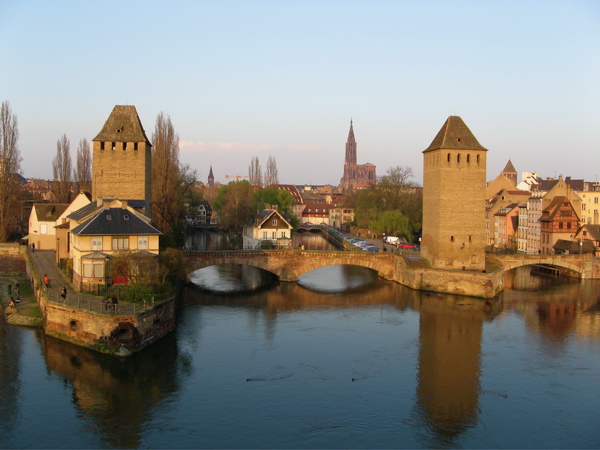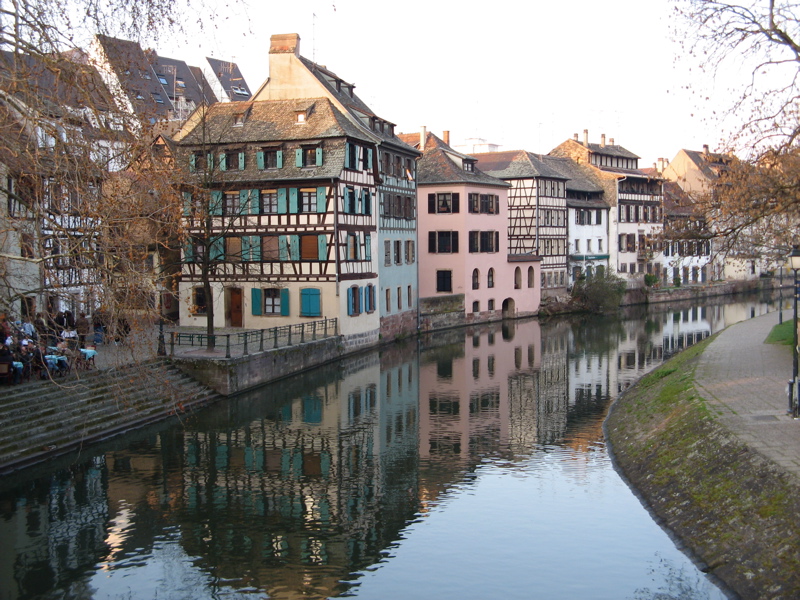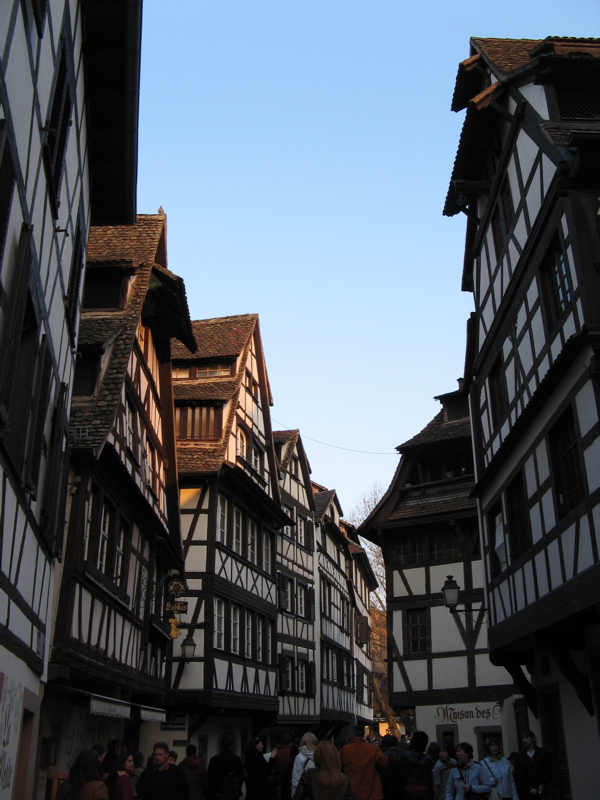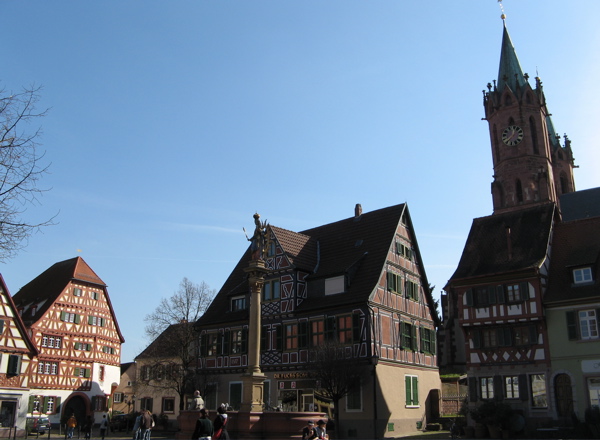We found a place for what we hoped would
be a light lunch, as we had decided we were going to have a nice dinner. Elyse
ordered a leek quiche and Gerald ordered a fried Camembert. We
thought that would consist of a few slices of cheese with the side
salad, but he received an
entire
Camembert fried! Both meals were delicious, but a bit more
filling than we expected! We went back to check on the Cathedral,
but Mass was still on, so we climbed the 330 steps up to the viewing
platform on the Cathedral (we figure that burned off about 2
bites of the Camembert). It had started to clear, so we were able to
see a fair bit. Just seeing the detail of the cathedral
was interesting enough. It is hard to fathom how many full-size
sculptures are on the outside of the building, never mind how much work
would have gone into the stained glass.
Next we headed to the Château des Rohans (pictured above, right - with the courtyard), the former 18th c.
residence of the prince-bishops, which houses three separate museums.
The top floor has the Musee des Beaux Arts, with a very impressive
collection of European paintings from the 14th - 19th centuries. The next floor was the most fun. It
contained both a collection of ceramics, furniture, toys, etc.
and the
private apartments of the royalty. The rooms in the apartments are
richly decorated and there is a fabulous library (pictured below, right), complete with
celestial and earthly globes on the long wooden table in the center.
The room on the left was the King's bedroom. It was pretty impressive to see. By the time we got to the
Archaeological Museum on the bottom floor, we were too tired to take
much in. It was an amazing collection of artifacts ranging from
prehistory to about 800 AD and was nicely displayed.
We tried the Cathedral once more, but now the Bishop was giving a
sermon, so we knew it was going to be a while! We had heard
an amazing soprano singing voice when we were at the top of the
Cathedral and heard it again in the plaza in front of the cathedral.
We traced it to a tattooed man playing the mandolin (see below).
We
decided to take a seat at one of the cafés outside the cathedral
so that we could listen to him while enjoying the view. To the
left of the cathedral is the stunning "Maison Kammerzell" (pictured
below, right). It is a rich merchant's house, built in 1589.
Not bad looking! Anyway, Elyse
ordered a hot chocolate (what else?) and Gerald a fresh orange juice
(we were still full, so no pastry!). Elyse received
a
bowl of hot chocolate, complete with a soup spoon -- it was a soup dish filled with hot chocolate, after all!
We sat and rested, listened to the music, enjoyed watching people and appreciated, once again,
how lucky we are.
We decided to try the Cathedral once last time before heading to another
section of town, and found people milling around inside. We were
now free to wander throughout the inside and to gape at the size and
beauty of the place. The cathedral took almost 300 years to
complete - from its beginnings in
1176 to the completion of the 142m high spire in 1439. That
explains
the mix of design a bit. The rose window at the back is exceptionally
brilliant - especially now that the sun was out - but all of the
stained glass was beautiful. The organ (just visible on the left of the middle photo below) dates from the Middle Ages
and is quite ornate (we had heard it during one of our earlier
visits). We were also able to see the astronomical clock that was
created in 1842 and sits toward the front of the church. It is
about 20 feet tall and has an elaborate display of figures moving every
day at 12:30 p.m. The cathedral is a beautiful and impressive building.
Now we (finally!) walked over to the other major highlight of
Strasbourg:
"Petite France". This is the old fishers', millers'
and tanners' district and has alleys along canals filled (the
alleys, not the canals) with half-timbered houses from the 16th and
17th centuries. It was early evening by now, so the light made
everything look that much more peaceful and pretty. The "Covered
Bridges", pictured below left, used to be covered, but now just have
the
fortified towers from the 16th century. Behind them (where we
were taking the picture from) is the "Vauban Barrage", a dam of sorts
built in 1690, which could flood the southern part of the city for
protection from invasion. This vantage point allowed us to take
in the beauty of the area before heading in amongst its narrow streets
to find a restaurant for dinner.



We decided on a restaurant called L'Eveil des Sens. It
had a fixed price menu that looked great. Gerald convinced Elyse
that she should get the 3- (vs. 2-) course special because "the
servings will probably be small." If one wanted dessert, one had
to order it at the beginning of the meal, so we both went for 3
courses. Gerald had foie gras to start (apparently Strasbourg is
famous for it -- if this restaurant's sample is any indication, we
understand why!), then a beef dish (cooked for 12 hours and served with
vegetables - cut like butter and tasted superb) and a Roquefort tart
with poached pears for dessert (yummy!). Elyse had a duck
"pastille" (stripped duck with a Mediterranean flavor encased in a
small filo package - fantastic!), followed by herb-coated veal (liver,
it ends up - didn't quite "get" that part from the French menu) and
an apple and cream "Mille Feuille" for dessert. We were both
satiated after the appetizers, full after the main courses and hurting
by the end of dessert. We decided that they make you order
dessert at the start because they know no one would have room for
dessert otherwise. Unfortunately we had to scoot out pretty
quickly after dessert so that we could catch our train home. It
was good that we had a couple of hours to let our digestive juices get
started before we were horizontal. We fell into our bed just
after midnight -- still full, but very happy. No breakfast the
next morning, that's for sure! Elyse pushed herself to have a
pastry for lunch (even though she still wasn't really hungry) because
she knows she will have to do without any pastry for this week of Passover!!
And that catches you up for now. April is sure to be a very busy
and exciting month as we have visits planned with friends and family.
We are very much looking forward to them and will let you know
what we were up to!
